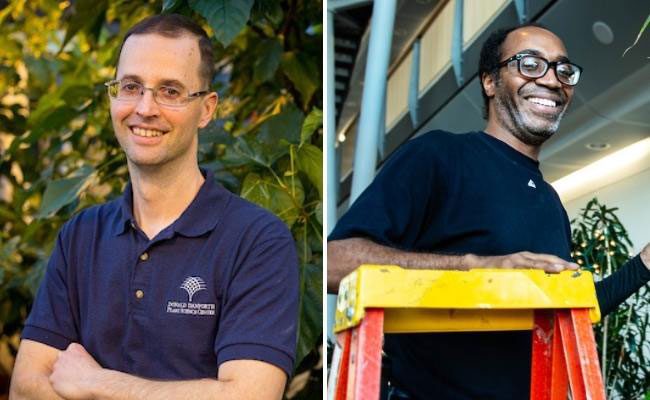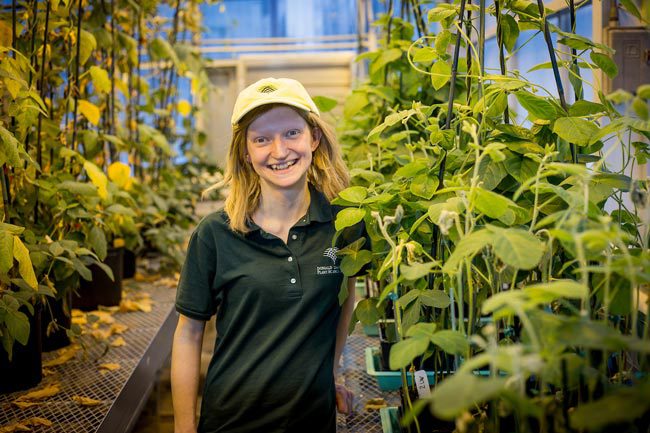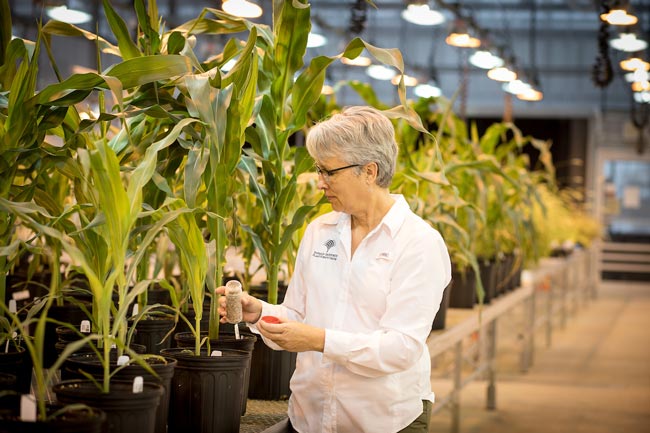Environmental Sustainability in the Plant Growth Facility
Did you know that since 2018 the Plant Growth Facility (PGF) team at the Danforth Center has replaced over 1,000 conventional greenhouse light fixtures with LED arrays? This infrastructure upgrade has not only reduced electrical usage by 34% across the affected houses, it has enabled more versatile research through better light control.
Ian Lastarria, PGF Maintenance Lead, played a key role in implementing the switch, including analysis of LED light spectra and working with team members to test the effects of the new systems. “It was cool to see how efficient the LEDs are,” says Ian. “They provide a broader spectrum of light for plant growth, while also saving energy. It is neat to see that we are trying to reduce the impact our facility has on the environment.”
So far, the team has converted 34 greenhouses to LED technology. A greenhouse LED conversion happens over a fast 48 hours, with Jim Pratt, PGF Operations Technician, coordinating with electricians and team members to complete the removal of existing lights and installation of new LED fixtures. Chris Martin, Utility Worker, is critical to the LED installation program, explaining that the work was both physical and technical. “You have to keep in mind the overall goal of the layout plan and physical installation of the lighting,” he says.

From left to right: Jim Pratt, PGF Operations Technician in the Plant Growth Facility; Chris Martin, Utility Worker at the Danforth Center.
Aileen Kidwell, Horticulturist II, had a critical hand in testing several crops under LED conditions, collecting data to ensure that plant performance would not be adversely affected. “We took data on plant height, yield, branching structures, main stem diameter, and crop cycle times, noting every watering change, pest, and spray that may have affected our results,” explains Aileen. “We were pleased to find that a majority of the plants thrive under the LEDs, needing little to no changes in our care protocols. The LEDs have saved us a lot of time that we now can use to improve the facility in other ways.”

Aileen Kidwell, Horticulturist II in the Plant Growth Facility, standing next to plants in the Danforth Center greenhouses.
Christian Lastarria, Director of Facilities Support Services, led the effort to obtain energy rebates from Ameren and enroll the Center in Ameren Missouri's BizSavers Energy Efficiency Program. As of February 2022, the Center has received or been promised more than a quarter of a million dollars in cash incentives from Ameren Missouri.
Building a Biological Control Program
The PGF team is also helping reduce the facilities’ environmental footprint through development and improvements in the biological control program, which uses beneficial insects to control pests. Sally Fabbri, Greenhouse Manager, has led this effort since starting at the Center eight years ago. Sally and the PGF team have reduced traditional pesticide usage by 64 percent over the past three years.

Sally Fabbri, Greenhouse Manager, with container of beneficial insects in the Plant Growth Facility
“We sprayed the most pesticide in greenhouses with corn to control two-spotted spider mites,” explains Sally. “Now we rarely spray because it is almost completely controlled by predatory mites. After that success we started to add biologicals to different crops.” The program requires more education of staff and coordination among team members, but the environmental and human safety benefits make it well worth the effort. “I’ve enjoyed the process because it is a whole systems approach to starting with a problem and experimenting to get the desired result,” explained Sally. “There were times when I thought I would never control mites on corn, but it worked! That’s rewarding to see.”
Innovating Into the Future
The PGF team is now looking to implement sustainability measures around water use reduction, fertilizer and plastic reduction, and more. “The ongoing sustainability efforts in the Plant Growth Facility are terrific examples of how teamwork, innovative thinking, and cross-departmental collaboration can lead to impactful projects supporting the Center’s mission and values,” says Kevin Reilly, Director of the Plant Growth Facility. “It’s very rewarding to implement a solution like the LED program that is not only more sustainable, but also improves research quality, all while being more cost-effective in the long run.”